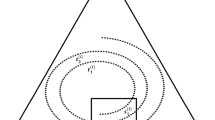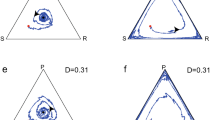Abstract
We investigate the dynamics of three-strategy (rock–paper–scissors) replicator equations in which the fitness of each strategy is a function of the population frequencies delayed by a time interval \(T\). Taking \(T\) as a bifurcation parameter, we demonstrate the existence of (non-degenerate) Hopf bifurcations in these systems and present an analysis of the resulting limit cycles using Lindstedt’s method.



Similar content being viewed by others
References
Erneux T (2009) Applied differential delay equations. Springer, New York
Guckenheimer J, Holmes P (2002) Nonlinear oscillations, dynamical systems, and bifurcations of vector fields. Springer, New York
Hofbauer J, Sigmund K (1998) Evolutionary games and population dynamics. Cambridge University Press, Cambridge
Miekisz J (2008) Evolutionary game theory and population dynamics. In: Multiscale Problems in the Life Sciences. Lecture Notes in Mathematics, 1940. Springer, Berlin, pp 269–316
Nowak M (2006) Evolutionary dynamics. Belknap Press of Harvard University Press, Cambridge
Sigmund K (2010) Introduction to evolutionary game theory. In: K. Sigmund, (ed) Evolutionary game dynamics, Proceedings of Symposia in Applied Mathematics, vol 69. American Mathematical Society, Providence. Paper no. 1, pp 1–26
Taylor P, Jonker L (1978) Evolutionarily stable strategies and game dynamics. Math Biosci 40:145–156
Yi T, Zuwang W (1997) Effect of time delay and evolutionarily stable strategy. J Theor Biol 187(1):111–116
Author information
Authors and Affiliations
Corresponding author
Appendices
Appendix 1: Derivation of replicator equation
Consider an exponential model of population growth,
where \(\xi _i\) is a real-valued function that approximates the population of strategy \(i\) and \(g_i(\xi _1,\ldots ,\xi _n)\) is the fitness of that strategy. The replicator Eq. [7] results from Eq. (109) by changing variables from the populations \(\xi _i\) to the relative abundances, defined as \(x_i \equiv \xi _i/p\) where \(p\) is the total population:
We see that
where \(\phi \equiv \sum _i x_i g_i\) is the average fitness of the whole population.
By the product rule,
Therefore,
So, using the fact that
Equation (118) reduces to the identity
The fitness of a strategy is assumed to depend only on the relative abundance of each strategy in the overall population, since the model only seeks to capture the effect of competition between strategies, not any environmental or other factors. Therefore, we assume that \(g_i\) has the form
Under this assumption, Eq. (116) is the replicator equation,
where \(\phi \) is now expressed entirely in terms of the \(x_i\), as
Mathematically, \(\phi \) is a coupling term that introduces dependence on the abundance and fitness of other strategies.
Appendix 2: Coefficients generated in the RPS problem
The entries of the matrix \(J\) from Eq. (34) are
where \(x^*\) and \(y^*\) are the coordinates of the interior equilibrium point,
The coefficients in Eqs. (52) and (53) are
The coefficients \(B_1,\ldots ,B_4\) in Eqs. (77) and (78) are
where \(r\) and \(s\) are as in Eq. (74).
Appendix 3: Removal of secular terms in Lindstedt’s method with delay
Consider a system of differential delay equations of the form
where \(\bar{u} = u(t-\omega T)\) and \(\bar{v} = v(t-\omega T)\), and where \(\omega \) and \(T\) are such that the associated homogeneous problem,
admits solutions of the form \(\sin t\) and \(\cos t\), or equivalently \(\mathrm{e}^{i t}\).
Substituting \(u=r \mathrm{e}^{i t}\) and \(v=s \mathrm{e}^{i t}\) into Eqs. (151) and (152), we obtain the characteristic equations
Rearranging, these become
Define
A non-trivial solution for \(r\) and \(s\) requires that \(\det R = 0\). Separating the real and imaginary parts, this means that
Equation (158) tells us that
(We neglect the alternate possibility that \(\cos (\omega T)=0\).) Then, we substitute this back into Eq. (157) to obtain
Under the conditions (159) and (160), the solutions to Eqs. (149) and (150) will in general have secular terms:
We wish to derive conditions on the \(K_i\) in Eqs. (149) and (150) such that the \(n_i\) are all equal to 0.
We substitute the solutions (161) and (162) into Eqs. (149) and (150), and set the coefficients of \(\sin t\), \(\cos t\), \(t\sin t\) and \(t\cos t\) separately equal to 0 in both equations.
The coefficients of \(\sin t\) and \(\cos t\) give us a system of linear equations on the \(m_i\) and \(n_i\), of the form
where \(\mathbf m = (m_1,\ldots ,m_4)^\mathrm{T}\), \(\mathbf n = (n_1,\ldots ,n_4)^\mathrm{T}\) and \(\mathbf k =(K_1,\ldots ,K_4)^\mathrm{T}\).
Similarly, the coefficients of \(t\sin {t}\) and \(t\cos {t}\) give us a system of linear equations on the \(n_i\), of the form
By row reducing in Mathematica, we find that both \(M\) and \(S\) have rank 2. To eliminate the \(n_i\), we proceed as follows:
-
Without loss of generality, set \(m_3=m_4=0\).
-
Solve any two independent rows of Eq. (164) for \(n_3\) and \(n_4\) in terms of \(n_1\) and \(n_2\). The result is
$$\begin{aligned} n_3&=\frac{n_2 \omega \cos (\omega T)-n_1 (\alpha +\omega \sin (\omega T))}{\beta } \end{aligned}$$(165)$$\begin{aligned} n_4&= -\frac{n_1 \omega \cos (\omega T)+n_2(\alpha + \omega \sin (\omega T))}{\beta } \end{aligned}$$(166) -
Substitute these expressions for \(n_3\) and \(n_4\) into Eq. (163). This is now a full-rank linear system of equations on \(m_1,m_2,n_1\) and \(n_2\). Solve this system to obtain expressions for \(m_1,m_2,n_1\) and \(n_2\) in terms of the \(K_i\).
-
Substitute the expressions for \(n_1\) and \(n_2\) from the previous step into Eqs. (165) and (166). Now we have all the \(n_i\) in terms of the \(K_i\).
-
Set the \(n_i\) expressions equal to 0. This gives a rank-2 system of equations on the \(K_i\), so it is possible to solve for \(K_3\) and \(K_4\) in terms of \(K_1\) and \(K_2\). The result is
$$\begin{aligned} K_3&= \frac{\gamma (K_1 (\alpha +\omega \sin (\omega T))+K_2 \omega \cos (\omega T))}{\alpha ^2+2 \alpha \omega \sin (\omega T)+\omega ^2} \end{aligned}$$(167)$$\begin{aligned} K_4&= \frac{\gamma (K_2 (\alpha +\omega \sin (\omega T))-K_1 \omega \cos (\omega T))}{\alpha ^2+2 \alpha \omega \sin (\omega T)+\omega ^2}. \end{aligned}$$(168)Using Eqs. (159) and (160), these reduce to
$$\begin{aligned} K_3&= \frac{K_1 (\delta -\alpha )-K_2 \sqrt{-(\alpha -\delta )^2-4 \beta \gamma }}{2 \beta } \end{aligned}$$(169)$$\begin{aligned} K_4&= \frac{K_1 \sqrt{-(\alpha -\delta )^2-4 \beta \gamma }+K_2 (\delta -\alpha )}{2 \beta }. \end{aligned}$$(170)
If Eqs. (169) and (170) hold, then there are solutions of Eqs. (149) and (150) with no secular terms.
Rights and permissions
About this article
Cite this article
Wesson, E., Rand, R. Hopf Bifurcations in Delayed Rock–Paper–Scissors Replicator Dynamics. Dyn Games Appl 6, 139–156 (2016). https://doi.org/10.1007/s13235-015-0138-2
Published:
Issue Date:
DOI: https://doi.org/10.1007/s13235-015-0138-2




